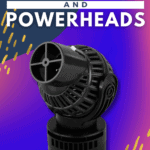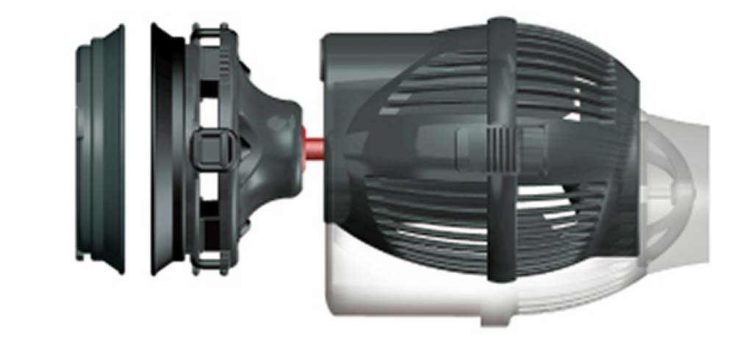I don’t want to make any waves, but if you’ve been struggling with your reef tank you might need to improve your water circulation. Stagnant areas reduce the health of your fish and can be deadly to corals and anemones, so dive into our guide to the best aquarium wavemakers and powerheads and learn how they can help!
Quick Comparisons Of The 7 Best Aquarium Powerhead Wavemakers
| IMAGE | BRAND | DETAILS | |
|---|---|---|---|
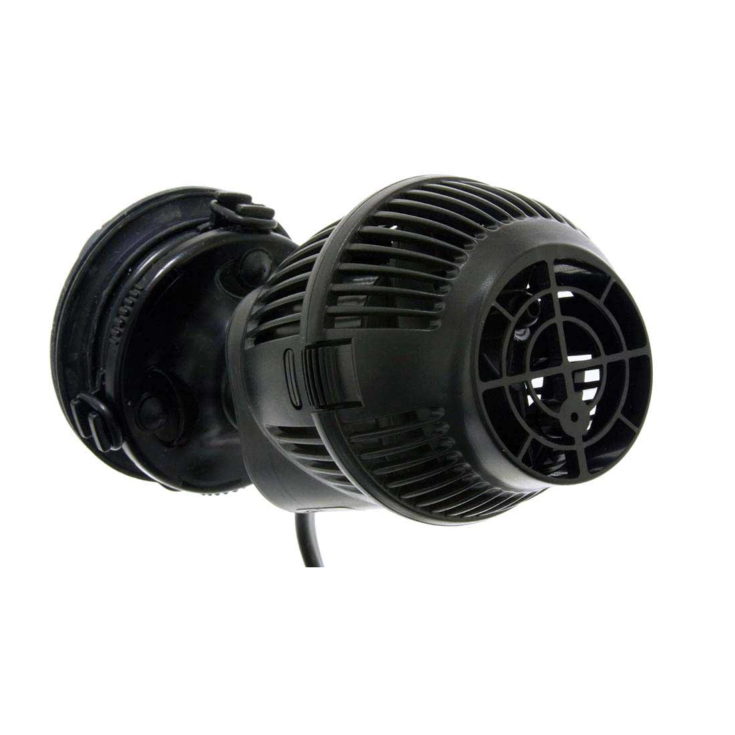 | Hydor Koralia Evolution Powerhead |
| View Product |
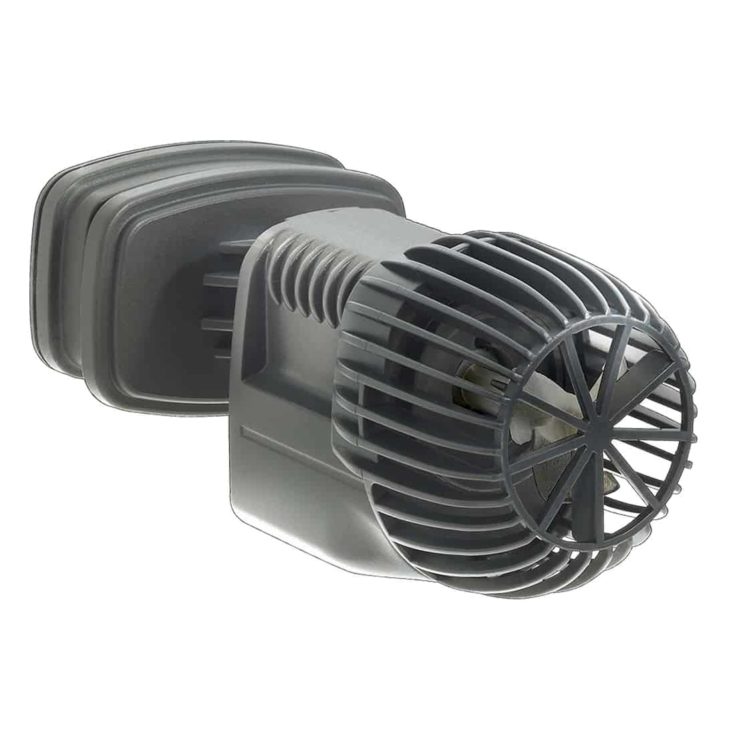 | Sicce Voyager Nano 2000 |
| View Product |
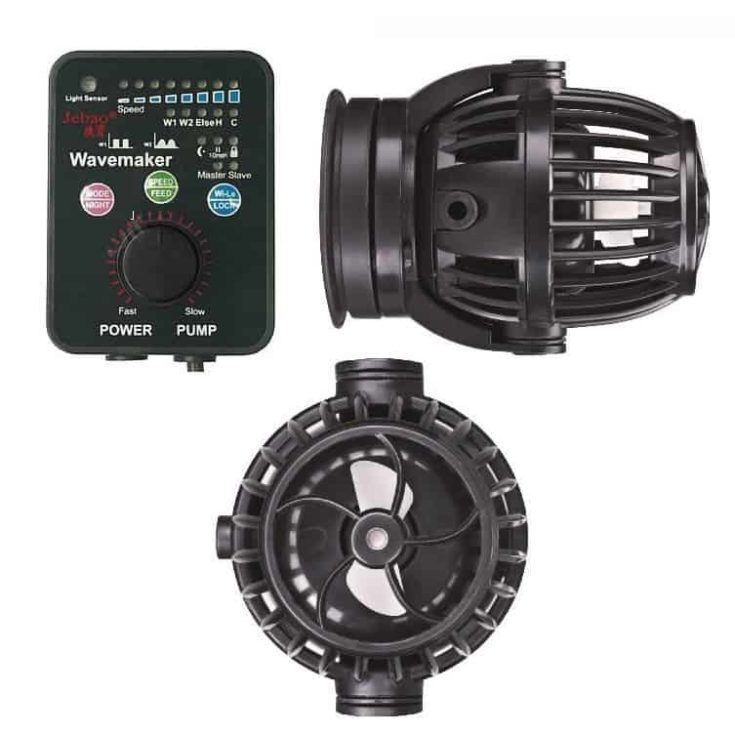 | Jebao RW Series Wavemaker with Controller |
| View Product |
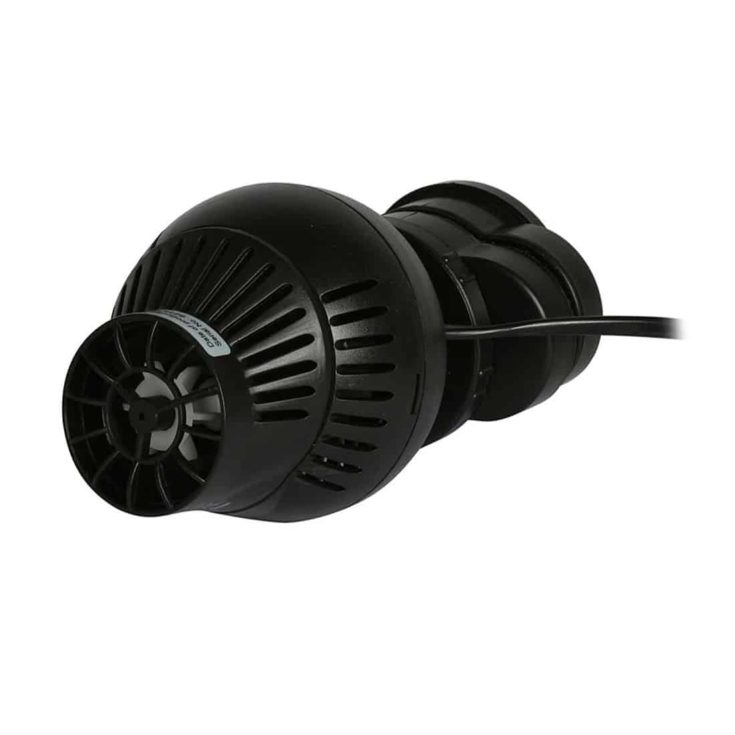 | JBJ Oceanstream Circulation Pump/Powerhead |
| View Product |
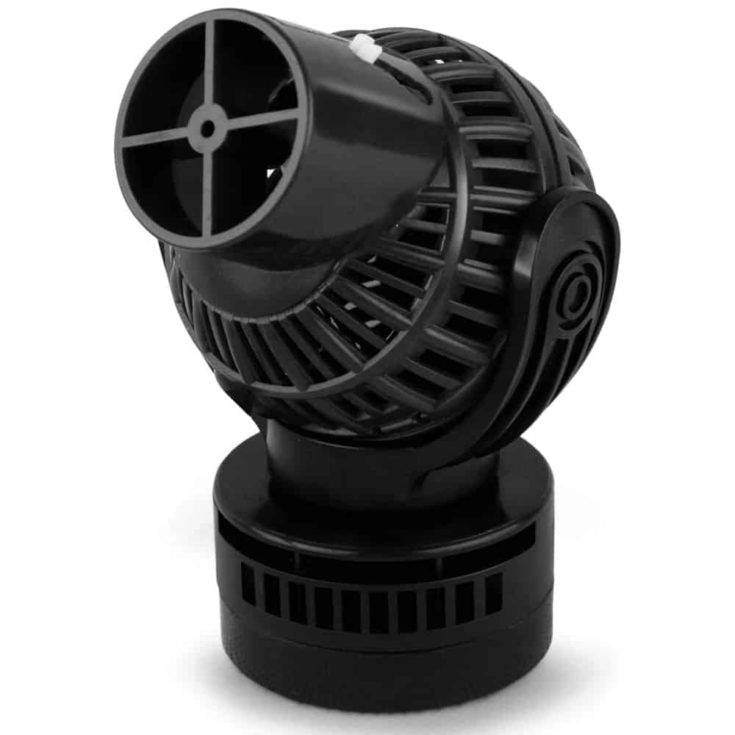 | FREESEA Aquarium Circulation Pump Powerhead |
| View Product |
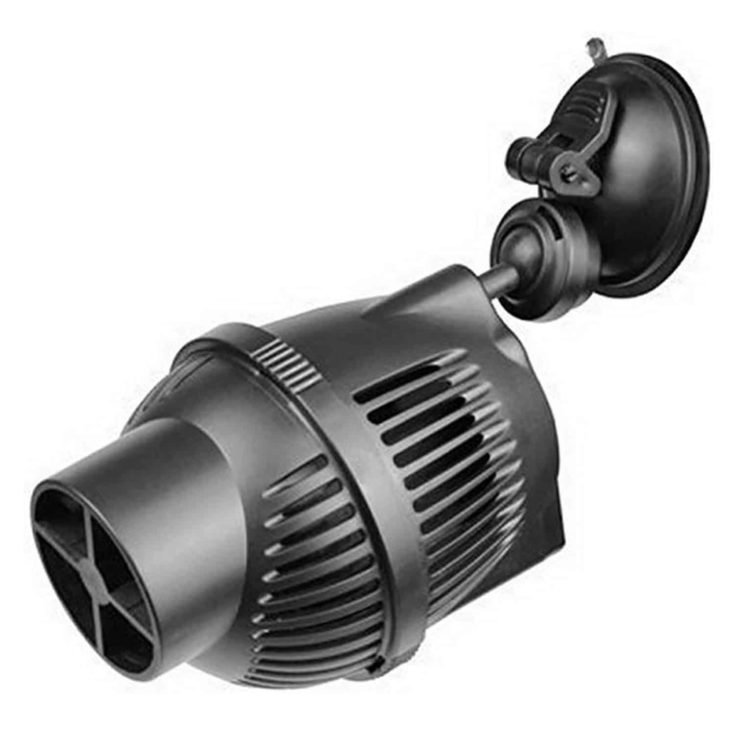 | Super Aquatic Aquarium Circulation Pump |
| View Product |
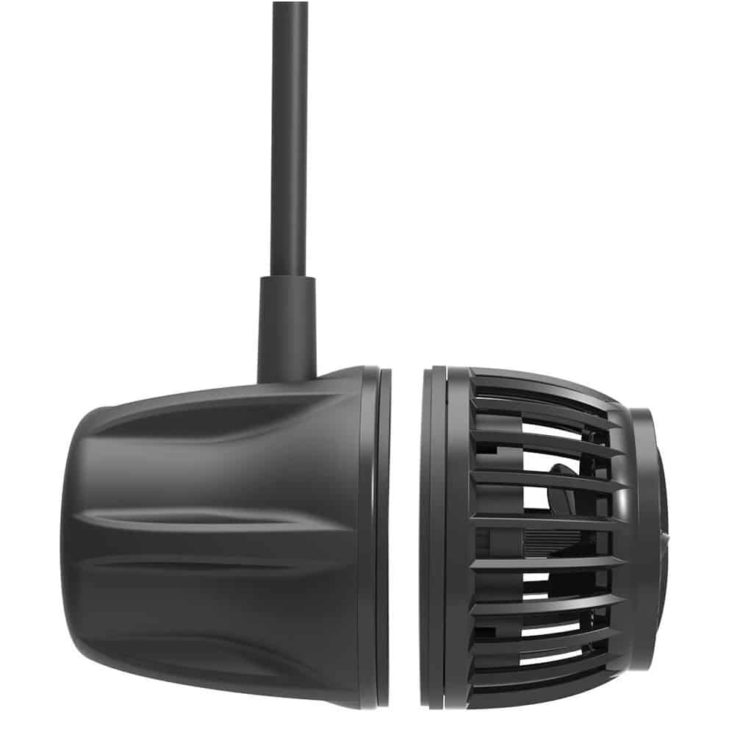 | Ecotech Marine Vortech MP10QD Wavemaker |
| View Product |
Guide to Wave Making Powerheads
When it comes to maintaining a healthy fresh or saltwater aquarium, one of the most important factors is your tank’s water circulation. As a closed system, areas in your tank can become stagnant and depleted of nutrients and oxygen unless you have equipment that carries the water to all corners of your aquarium.
Filtration systems and air-pump-driven bubblers like air stones and sponge filters can increase the movement and oxygen levels in your water, but they aren’t always adequate for stationary corals. They also can’t replicate the natural currents and tides seen in lakes and oceans. For that, you’ll need a wave-making powerhead!
What Are Aquarium Wavemakers and How Do They Work?
A wavemaker is an aquarium water pump with a circulating fan attached to it that you submerge inside your tank:

- The powerful fan (powerhead) directs a strong, narrow stream of water across the aquarium, causing turbulence and stirring up debris.
- Depending on your set-up and needs, several powerheads can be used together to generate currents that flow evenly around your decor to every corner of your tank or to generate waves of water.
- A true aquarium wavemaker includes at least one powerhead and a special controller unit that can vary the rate of the fan’s spin to generate the low-pressure/high volume current needed to simulate real waves.
Benefits of Aquarium Wavemakers
Should you consider adding a powerhead to your aquarium, or splashing out on a more intricate system including a powerhead and wavemaker controller? While they are most commonly seen in marine set-ups and reef tanks, wavemakers can also be helpful for maintaining planted freshwater aquariums, too. Here are their benefits:
Ideal for Corals and Reef Tanks, and Aquariums With Active Fish
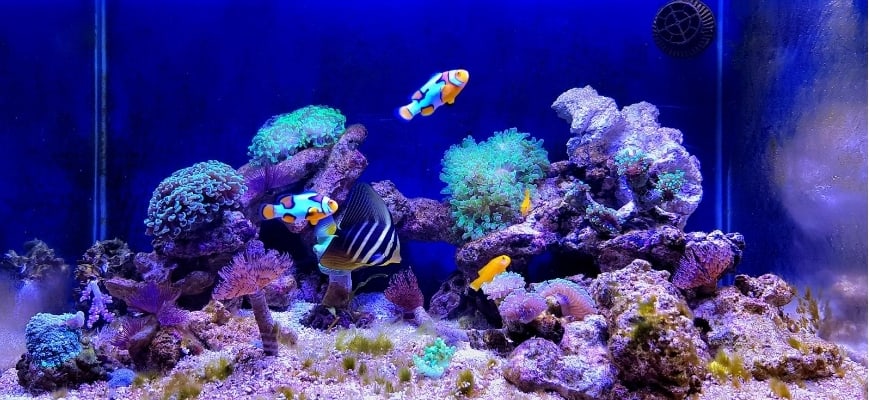
Unlike fish, who can swim towards their food or away from areas that are stagnant, corals are stationary and can’t move. They depend on the lights and currents in your aquarium for their very survival.
- If the water around your corals is lacking in oxygen, nutrients or microscopic particles of food, your reef may struggle to thrive and may even starve to death.
- Increasing the water flow around your tank often dramatically improves the health and appearance of corals and brings out their most vivid colors.
The variable currents created by fresh or saltwater powerheads also stimulate your fish, encouraging them to swim and show off their natural behaviors!
- Using a powerhead in your tank can be a great way to meet the needs of fish like freshwater sharks, who enjoy swimming against a strong current.
- Increasing the activity in your tank helps prevent obesity and boredom in your fish and makes your aquarium far more interesting to observe!
Eliminates Dead Zones and Debris Piles
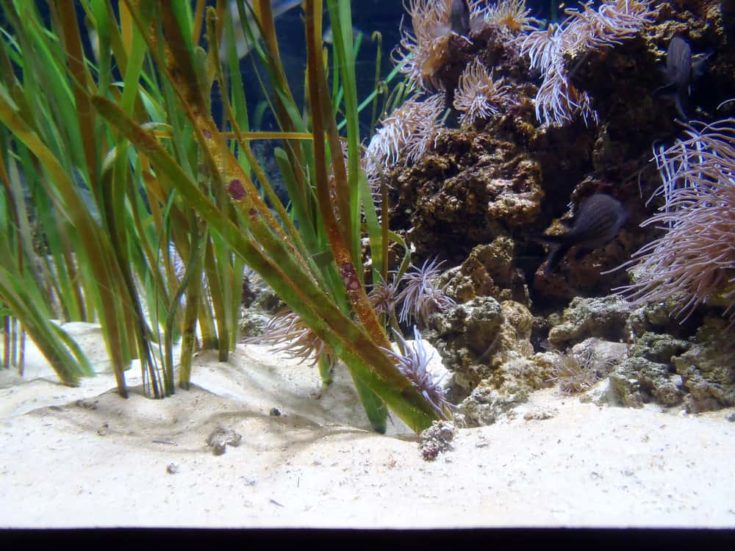
Dead Zones, or areas of depleted oxygen, can be a real problem in many aquariums and are often deadly in reef tanks. These areas may also lack the micro nutrients and steady flow of phytoplankton corals need to thrive. Using powerheads, water can be circulated to all areas of your aquarium and eliminate these stagnant areas for good.
Wavemakers can also boost your filter’s efficiency by pushing debris away from your decor and towards the filter intakes. Fish waste, decaying food and other detritus often collects around the base of your decor or live plants, where they are sheltered from the filtration system’s intake and outtake flows.
Helps Protect Your Tank From Dangerous Power Outages
Another reason to consider adding a reef tank wave maker to your aquarium is to protect your corals from harm if you suffer a power outage:
- Wavemakers and circulating powerheads use less energy than your filtration and sump pumps, and can often be maintained using an appropriate battery back-up (purchased separately, of course).
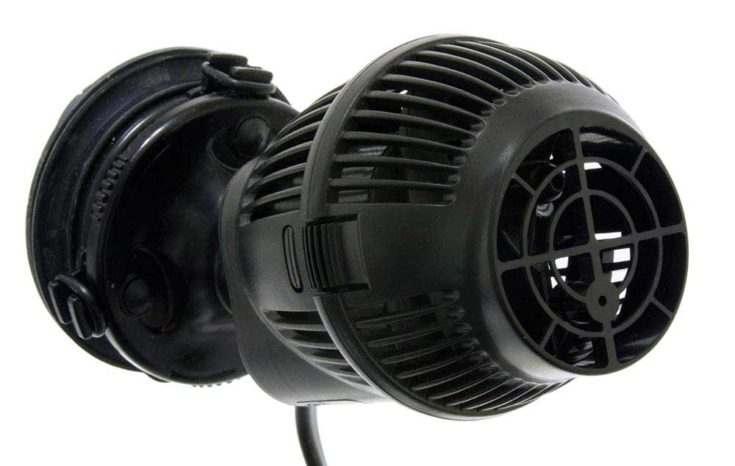
- The circulation from the powerhead may be sufficient to prevent a dangerous lack of oxygen or spike in ammonia while your main filters are down.
- Using a battery back-up along with your wave maker is substantially less expensive than setting up an external generator to maintain your full filtration and light systems during an outage.
If you’re interested in using your wavemaker as part of your emergency power outage set-up, you’ll have to be sure you purchase a powerhead that can run on battery back-up. Cheap powerheads often do not have this capability, so research and test your back-up system before you lose power to be sure it works as you intend.
Top 6 Benefits of Using Wavemakers and Powerheads in Aquariums
- Water movement makes your aquarium look more interesting and realistic.
- Provides hard and soft corals with a reliable stream of nutrient-rich saltwater.
- Mimics natural water currents, encouraging fish to be active and swim in the flow.
- Eliminates dangerous Dead Zones and areas of stagnation in your tank.
- Pushes debris towards your filter intakes for a cleaner, tidier appearance.
- Energy-efficient powerheads/wavemakers are ideal for use with a battery back-up system, which can protect your tank and the occupants during a power outage.
Types of Aquarium Water Pumps
The most confusing part of researching water pumps, wavemakers, and powerheads, is that aquarists often use the terms interchangeably, even though they can have very different functions. As technology advances, there’s increasing overlap between the various products as well, which only adds to the novice fish keeper’s confusion.
There are essentially 4 types of water pumps for aquariums, but only two of the four are suitable for use as a wave pump:
Filtration Pumps
Your aquarium’s filtration systems rely on strong pumps to move water through your filter media and back into your tank. They work under high pressure, so the water is only able to move in one direction and can’t flow backwards in the system. These pumps use a lot of energy and are not suitable for wave-making.
Aquarium Return Pumps and Circulation Fans

Circulation pumps move water from one part of your tank to another, and are most commonly used in sump systems to return the clean water to your tank. These return pumps use a lot of energy, because they need a high head pressure to move the water up the line against gravity.
There are also simpler, low-pressure circulation fans that sit inside your main tank and move the water around. Many look nearly identical to the smallest powerheads, but can’t provide the same strong stream of water. These cheaper circulation fans are not adequate for wave-making but are often ideal for planted freshwater tanks.
Powerheads
How is a powerhead different from a circulation fan? Truthfully, these products have become muddled over the last decade and the differences have become much smaller. A powerhead has an energy-efficient motor capable of spinning the propeller blades very fast, to generate a narrow, strong current and plenty of turbulence.
So for the aquarium circulation pump vs powerhead debate, it just depends on the actual products you’re considering. You’ll have to compare the specifications and reviews to get a sense if it’s just a circulation fan or a more powerful wave-making powerhead you’re looking at.
Wavemakers
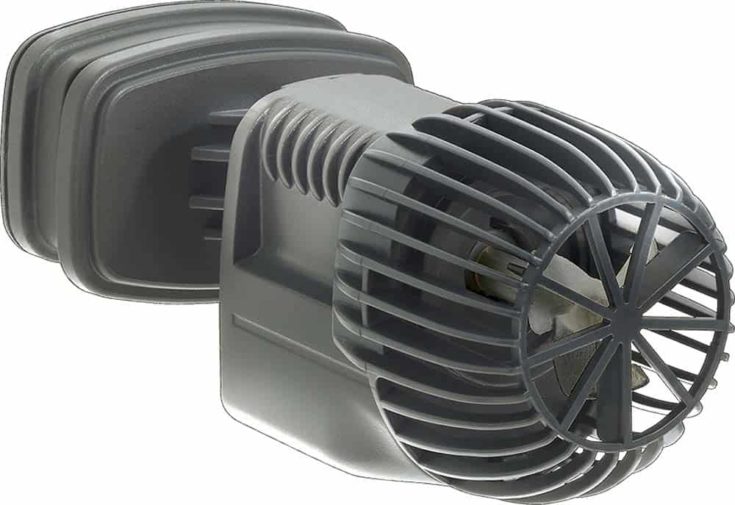
Wavemakers and powerheads can both be used to generate currents in your aquarium, so why would you pick one system over the other? Actually, a real wave-making system includes at least one powerhead and often has several working together to provide flow to all areas of a large tank.
There are three parts to a true Wavemaker system:
- At least one powerhead
- The controller panel
- The power supply (power brick)
The controller is the key part that allows the powerheads to generate waves. As you’ll read below, without a controller, a powerhead can only spin continuously at one speed and some won’t work at all. The controller allows the powerhead to spin at a variable rate and even start and stop, creating alternating flows of water in your tank.
Wave making controllers add a lot to the expense of these systems, and many aquarists start with a powerhead and only add a compatible controller later when they want or need a more customizable set-up. True wavemakers are more energy-efficient than standard powerheads and cost less to run over their lifetime.
What’s the Difference Between AC and DC Wavemakers?

Wavemakers require electricity to power their small magnetic motors. There are many different types of electrical motors, but home aquarium powerheads and wavemakers use either AC or DC currents for power. Whether you opt for an AC or DC wavemaker has a direct impact on its price, function and limitations.
How Do AC Powerheads Work?
AC, or alternating current powerheads, take advantage of the regular swing between positive and negative charges inside the stator (or stationary part of the motor) to spin the rotor and propeller blades. Small magnets on the rotor interact with the stator’s alternating magnetic field as they “lock” together and spin.
There are several benefits to using these powerheads. They are very reliable and can be inexpensively manufactured, and the only point of failure to worry about long term is the motor. But they use more energy to run and can be noisy as well, and many budget AC powerheads simply won’t work with a wavemaker controller.
Powerheads can also spin in either direction unless they have an anti-reverse device installed. If you’re using a controller with your AC powerhead you’ll need to be sure it will reliably start spinning in the correct direction. Keep in mind that using a controller with your AC device may also cause the motor to wear out faster.
Wavemaker Controllers Convert AC to DC

Here’s another confusing engineering fact: Nearly all powerheads, even those that come in wave-making kits, are AC powered. While true wavemakers use a type of brushless DC motor (BLDC) to power their magnetic rotor, they still rely on the AC’s alternating magnetic field inside the stator to generate the spin.
So where does the DC part come into play, you ask? The difference between a simple AC powerhead and a true wave-making system is in the special controller unit that converts AC to DC power and allows the rotor to turn at a variable rate:
- Electronics in the controller can convert the DC into any frequency of AC needed to spin the rotor at the desired speed.
- The rate of rotation in a BLDC motor can be adjusted while the motor is running, allowing for very precise rotational control without sacrificing the power (or torque) or damaging the motor.
- BLDC wavemakers can produce a very powerful flow of water using a much smaller, more efficient motor.
- This reduces the energy consumption of the motor and allows it to run off of battery power, if needed, since it operates at a much lower voltage than the AC powerheads.
- There are also no cord aquarium wavemakers, which operate entirely on batteries instead of using your home’s electricity.
- In both cases, though, the lower voltage makes DC wavemakers safer for use in saltwater tanks (saltwater conducts electricity).
Powerhead
Pros
- Reliable and durable; should last for years even with constant use
- Inexpensive
- “Plug and play” operation makes it easy for novice’s to use
- Energy-efficient and cost less to operate than filtration or return pumps
- Single unit and the main point of failure is the motor
Cons
- AC motors are noisier and make a noticeable click when starting
- Fan blades are bi-directional and may not spin correctly on start-up
- Uses more energy and costs more to operate than wavemakers
- Many powerheads can not be used with controllers or battery back-up systems
- Using a compatible AC powerhead with a controller may cause the motor to fail sooner from the extra wear and tear
Wavemaker System
Pros
- Extremely quiet operation
- More energy efficient than other water pumps and cost the least to run
- Multiple powerheads can be used simultaneously and programmed for customized water movements
- Converter allows the motor to spin at variable rates using a lower voltage, which is safer in saltwater tanks
- Low energy use makes them ideal for use with a battery back-up system during power outages
Cons
- More expensive initially, and premium systems may cost several hundred dollars to install
- Multiple parts increases the possibility of failures in the controller, motor or power source
- Harder for novices to master the use of the controller and get the circulation they desire
- Wavemakers are newer than powerheads and the technology hasn’t been refined as much
- Many budget wavemakers are made by unknown brands and are often of questionable quality
How to Choose the Best Wavemaker for Your Tank
Now that you understand their benefits and how the various powerheads and wavemakers work, how do you go about picking the best option for your tank? I think the first thing to consider is whether you simply need a single powerhead, or whether you’d prefer to get a complete kit including a wave controller.
If you anticipate upgrading in the future by adding more powerheads, or want to create special wave patterns or effects in your tank, then you’re probably better off investing in a wavemaker. While many premium powerheads are now compatible with aftermarket controllers, they usually wear out faster when used this way.
What Size Wavemaker Do I Need?
There’s no easy answer to this question, because it completely depends on how you plan to use the powerhead and the type of tank you have. If you’re using these devices in freshwater or planted tanks the ideal flow rate or turnover (in gallons per hour or GPH) will be lower than for fish-only saltwater or reef tanks.
That’s because saltwater is denser than freshwater. You’ll notice that high-quality powerheads will have a different capacity rating for freshwater and marine applications, and a pump that can handle a 100-gallon freshwater tank may only be suitable for a 30 to 50-gallon saltwater aquarium.
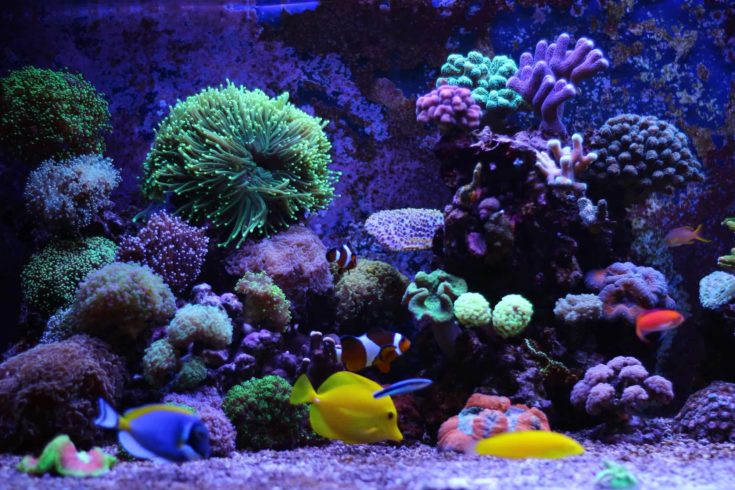
In most cases, you’ll have to research and play around with your pump to find the best set-up for your tank’s needs. Reef aquariums have the most specific requirements for their GPH turnover, since corals depend on the water movement for their survival:
- Powerheads/wavemakers for reef tanks should be able to turnover 20 times the tank’s capacity every hour.
- So a nano wavemaker for a 15-gallon reef tank needs a 300 GPH powerhead to be adequate (20 x 15 = 300).
- However, you can also have problems if the powerhead is too strong for your tank’s capacity or the application you’re using it for, so don’t buy one that’s more powerful than you need!
Price
Wavemakers are available in a wide range of prices. I’ve seen cheap units for sale at under $20, while premium systems including a controller can easily top $300. In general, buying a powerhead, even a high-quality model from a recognized brand, will cost substantially less than investing in a system with the controller.
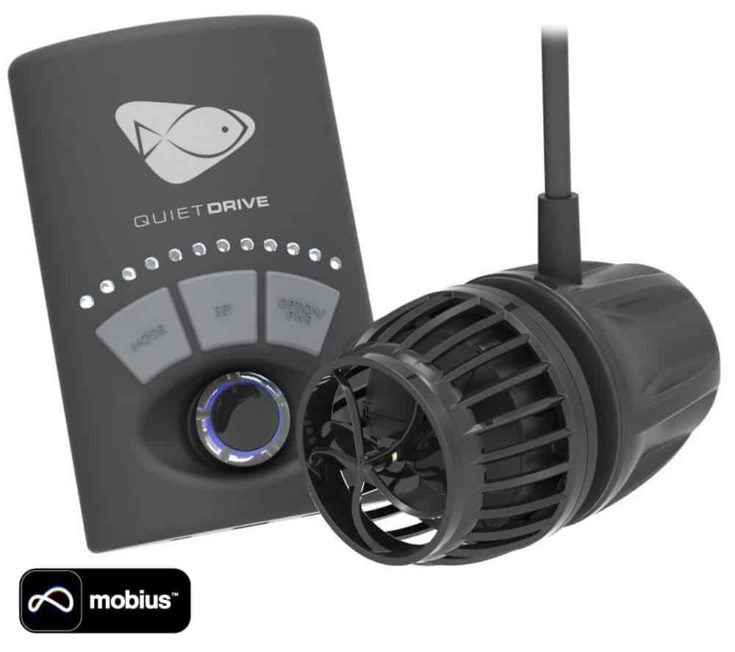
Of course, if you get a compatible powerhead, you may be able to add a controller at a later point. But you may be limited to buying a certain brand of controller, and the powerhead may need replacing sooner since the motor will experience more wear and tear that may not be covered under warranty.
Warranty and Customer Service
In an ideal world, powerheads should last a long time. I’ve had powerheads that ran continuously for 15 years and were still going strong! Wavemakers, on the other hand, are newer, more complex products, and the controllers and power supply bricks are especially liable to need repair.
I’d look for products with a robust and long-lasting warranty, especially on the motor/rotor assembly and the controller and power brick (if they come with one). I’d be cautious of buying from a manufacturer that doesn’t have a solid web presence, since it may be difficult to contact them if you have a problem and need help.
If you’re only buying a powerhead but plan to use it with an aftermarket controller, be sure the warranty covers the extra wear on the motor. Otherwise, the manufacturer may not cover a broken or worn powerhead and you’ll have to replace it at your own cost.
Safety
Anytime you plan on mixing electronics and water you should be concerned about safety, especially if you have saltwater tanks. Go with products made by well-known manufacturers with a strong record of safety, and avoid bargain-basement powerheads and unknown brands with little history in home aquatics.
Another option is to look for products with features that enhance safety. Magnetic powerheads, for instance, isolate the electronic components from the parts that sit in the water. This design reduces the potential for an electrical short or other water-related problems in your set-up, but may also come with other downsides.
Durability
Powerheads have long been used in aquariums and are known for their durable construction and long-lasting operations, while wavemakers are considered less durable and more likely to have problems. But how can you identify which models are more durable when there’s so many options? Online reviews can be helpful with this!
This is less critical for freshwater applications, since saltwater is much more corrosive. When choosing a powerhead/wavemaker for a marine tank, look for models that use ceramic rotors or impellers instead of stainless steel. These usually last longer, since the ceramic won’t corrode when exposed to the saltwater.
Ease of Installation
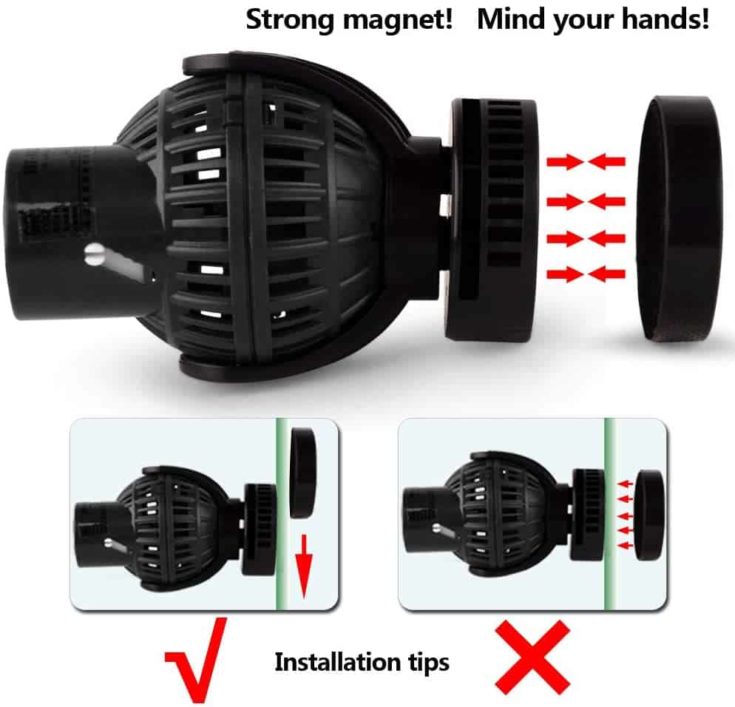
Most powerheads are essentially plug and play. You drop them in your tank, secure them in place and plug them in. You may need to change the direction or spread of the water flow, but there’s not a lot of tricky adjustments involved. But wavemakers with controllers are more complex, and you’ll have to study the manual to use them.
My tip for ensuring that you get a wavemaker that’s easy to use is to download the manual BEFORE you buy the product. Read through it and make sure you understand how it works. If the manual is badly written or filled with misspelled words and confusing diagrams, skip it and pick another, and you’ll save a lot of frustration.
Efficiency
Powerheads and wavemakers are both energy efficient, but the wavemaker’s BLDC motor uses less energy and is less expensive to operate over its lifetime. Their lower energy use makes them ideal for battery back-up systems as well. Some powerheads, especially budget models, won’t work with battery back-ups at all.
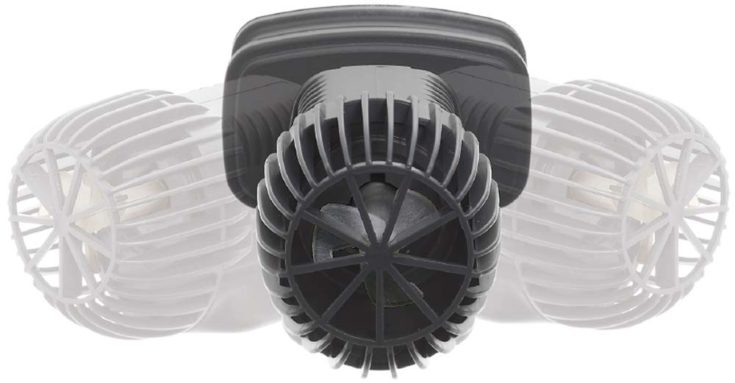
If you have other equipment that uses a controller, you may be able to get away with buying just the BLDC powerhead and power supply. Then you can use your existing controller for it rather than buying a new one. Premium fish tank lights and wavemakers often use the same kind of controller, so this could save a lot of money!
Noise
Powerheads that run on AC are noisier than BLDC wavemakers, and often have a noticeable sound when they start up. These sounds usually get worse over time, and while replacing the impeller can reduce the noise, it’s still a problem for many aquarists. If noise is an issue for you, opt for a wavemaker instead of a powerhead.
Top 7 Aquarium Powerhead Wavemaker Reviews
Are you ready to make some waves or get the water moving in your tank? We’ve searched the internet to find the best wave-making devices for home aquariums. Whether you’re looking for a budget powerhead for your saltwater mixing tank or need a premium system for your reef tank, our list can point you in the right direction!
1. Hydor Koralia Evolution Powerhead

- Type: Powerhead
- Flow Rate/Watts: 850 GPH/4.5 Watts
- Dimensions: 5.5 x 2.75 x 2.75 inches
- Aquarium Size: Freshwater 50 to 100 Gallons; Saltwater 30 to 50 Gallons
If you need a compact but powerful powerhead for your reef tank, then you probably can’t do better than going with the Hydor Koralia Evolution. Designed specifically for small reef aquariums, the Evolution is an inexpensive workhorse of a water pump. It provides a steady 850 GPH stream that you can widen or narrow for complete coverage in your tank. The magnetic base and suction cups hold the powerhead securely in place, and the ball joint allows you to angle the powerhead to get the precise flow you need.
Even better, this powerhead is also compatible with some controllers, so you’ll have the option to turn it into a proper programmable wavemaker in the future if you want to. Hydor is a well-known manufacturer with excellent customer service, and their powerheads are considered some of the best and most durable in the business. Their warranties are impressive as well, and if you have problems with your powerhead you can count on getting their assistance.
| PROS | CONS |
|---|---|
|
|
2. Sicce Voyager Nano 2000

- Type: Powerhead
- Flow Rate/Watts: 530 GPH/3 Watts
- Dimensions: 2.4 x 1.7 x 2 inches
- Aquarium Size: Freshwater 30 to 50 Gallons/Saltwater 20 to 35 Gallons
Another compact but powerful option is this very small powerhead from Sicce. The Voyager 2000 is ideal for nano reef tanks up to 35-gallons and would make a nice addition to many larger freshwater tanks too. The magnetic base holds it securely in place, and the swivel head allows the powerhead to rotate 360° so you can easily arrange the flow any way you want. The vibration pads do a good job of minimizing the noise from the pump, although it’s still louder than true wavemaker pumps.
Despite its compact size, it produces a powerful stream of water, and the self-cleaning impeller reduces the amount of maintenance required to operate it. Some users actually find that the 2000 is too powerful for their small aquariums, so if you’re right on the edge you may be better off getting the smaller version. I wish it was made with ceramic parts instead of stainless steel and worked with a controller, though.
| PROS | CONS |
|---|---|
|
|
3. Jebao RW Series Wavemaker with Controller

- Type: Wavemaker
- Flow Rate/Watts: 180 to 2100 GPH/8 to 23 Watts
- Dimensions: 4.5 x 2.5 x 2.5 inches
- Aquarium Size: 25 to 100 Gallons
If you’d prefer to buy a full kit that includes a powerhead and controller, then consider the RW series from Jebao. You can connect up to 8 powerheads and control them using your home’s wireless connection. The variable rate powerhead can deliver from 180 to 2100 GPH and is fairly energy efficient. The wide magnetic base provides a very secure attachment to your tank and can be easily moved if you need to relocate or adjust it.
I wish I could recommend this product without reservations, but it definitely has some downsides. The Jebao wavemaker is a lot cheaper than the others on my list and their products have a reputation for quality control problems. This slightly bulky powerhead may work well for your tank, or you may have to replace it when the motor goes out or the controller stops working. It’s still a viable budget wavemaker under $100, but after a few years it may end up costing you more than if you’d bought a premium model.
| PROS | CONS |
|---|---|
|
|
4. JBJ Oceanstream Circulation Pump/Powerhead

- Type: Powerhead
- Flow Rate/Watts: 500 GPH/7 Watts
- Dimensions: 2.8 x 4.8 x 2.6 inches
- Aquarium Size: 10 to 30 Gallons
If you need a powerhead for your nano reef tank but worry about blasting your corals with a hard jet of water, then take a look at the Oceanstream from JBJ. This small powerhead has a unique paddle disk which diverts the water towards the sides of the housing for a more random, gentle current. This protects your fish and corals from injury and helps spread the current around your tank.
Since the Oceanstream is gentler than others on my list, this is probably the best option for nano reef tanks and would make a good choice for many larger freshwater tanks as well. Unlike many budget powerheads, this one can work with a controller, so you’ll have the option to upgrade your system later if you decide you want too. It’s not perfect, as the cord is shorter than average and the pivot ball attachment is rather delicate, but it’s a nice powerhead and it’s not expensive.
| PROS | CONS |
|---|---|
|
|
5. FREESEA Aquarium Circulation Pump Powerhead

- Type: Powerhead
- Flow Rate/Watts: 1056 GPH/6 Watts
- Dimensions: 5.5 x 4 x 3.2 inches
- Aquarium Size: 20 to 60 Gallons
Another option for a simple powerhead would be this adjustable flow model from Freesea. It provides a steady 1056 GPH and is fairly efficient to boot; in fact, it uses less energy and provides twice the flow of the JBJ above! The swiveling head is easy to adjust and the magnetic base holds it in place and makes it easy to move for cleaning or maintenance. The efficiency rating is definitely one of its selling points.
It’s described as an adjustable flow powerhead, but that doesn’t mean you can change the actual flow rate or GPH. Instead, you can widen or narrow the stream of water by selecting the forward or “high” (meaning wide) setting. This is a basic powerhead, but it isn’t really a budget model. It’s only slightly less expensive than the premium powerheads on my list, and it won’t work with a controller. It’s also on the bulky side.
| PROS | CONS |
|---|---|
|
|
6. Super Aquatic Aquarium Circulation Pump

- Type: Powerhead
- Flow Rate/Watts: 1300 GPH/12 Watts
- Dimensions: 6.4 x 4.6 x 4.4 inches
- Aquarium Size: 100 gallons and up
If you need a powerhead and you’re on a tight budget, allow me to introduce this powerful option from Super Aquatic. It’s a bit bulky, it doesn’t have any fancy features and you can’t use it with timers or a controller, but it is very inexpensive and can usually be found for under $20! The 1300 GPH motor gets the job done and only uses a modest 12 watts to do it!
This would be a reasonable choice for a larger aquarium, but be careful using it in tanks under 100 gallons. The strong water flow, which is adjustable to cover a wider or narrow area, can easily knock fish around your tank and damage corals in small set-ups. It’s not a good pick for nano tanks. It’s also the only powerhead on my list that doesn’t use magnets to secure the base in place, so you’ll have to play with the suction cups instead. It’s a bit noisy too, but should last until you can afford a better option.
| PROS | CONS |
|---|---|
|
|
7. Ecotech Marine Vortech MP10QD Wavemaker

- Type: Wavemaker
- Flow Rate/Watts: 1500+ GPH/8 to 18 Watts
- Dimensions: See manufacturer’s specs
- Aquarium Size: 2 to 50 Gallons
Finally, let’s talk about the best professional quality wavemaker and controller on the list, the Vortech MP10QD. If you want a system that can handle intricate programs, control multiple powerheads and is incredibly safe to use, then this is the wavemaker you should consider. The special design keeps all the cords on the outside of your tank and uses powerful magnets to connect to the impeller inside your tank. The cord and electronics never come into contact with water!
This design also saves space inside your tank, because the impeller housing is only 2.5 inches in diameter and only extends 1.5 inches into the tank. The bulkier motor sits outside, so you’ll need at least 2.25 inches of clearance on the side you locate it. You can adjust the programs using the controller, or through your smart device using their app. If you want a true wave maker for your reef tank, this would be my top pick!
| PROS | CONS |
|---|---|
|
|
Conclusion
Wavemakers and powerheads are an energy-efficient way to improve the circulation of water in your tank and are especially useful for maintaining reef systems. Powerheads are relatively inexpensive, while wavemaker kits allow you to customize the effects and deliver precision streams of water to all corners of your tank.
Of the products reviewed on my list, I’d absolutely choose the Vortech Wavemaker if the cost wasn’t a concern, or save up my money to buy it down the line.
- If you’re not ready to commit to such an expensive system, the Hydor Koralia is the best pick overall and won’t hurt your budget.
- For nano tanks, I’d prefer the Sicce Voyager or the gentler Oceanstream over the cheaper and less functional Jabao, Super Aquatic or Freesea.
